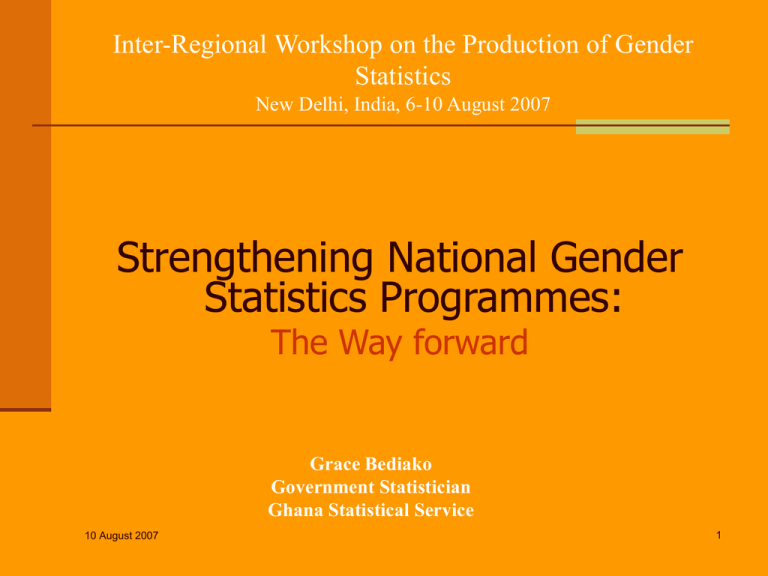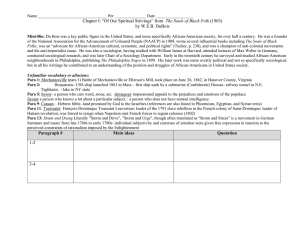Strengthening National Gender Statistics Programmes: The Way forward
advertisement

Inter-Regional Workshop on the Production of Gender Statistics New Delhi, India, 6-10 August 2007 Strengthening National Gender Statistics Programmes: The Way forward Grace Bediako Government Statistician Ghana Statistical Service 10 August 2007 1 The focus of the Session Where are we on gender statistics? Where do we need to be? How will we get to where we need to be? What are some milestones along the way? What will it take to take us from where we are now, through where we would like to be, to where we need to be? What are the next steps/“quick wins” for national gender statistics programmes? 10 August 2007 2 Major steps in the production process Defining data requirements Defining issues Statistics required from various fields Problems and questions on gender issues in society Relevant statistics/indicators Required improvements in the situation of women and men Determine data sources Goals for equal opportunity 10 August 2007 Assembling data Available statistics Data gaps Review quality Dissemination Statistics to be analysed Analysis Other sources Review concepts, methods, classifications, etc. Collect new data Presentation Dissemination 3 Role of producer-user dialogue Beginning stages of data collection Define issues Identify statistical needs Identify gaps 10 August 2007 Consultations/feedback in-between Advice on questionnaires design Producers of statistics Users of statistics Advice on concepts & methods Final steps in data collection Support analysis Identify gaps Feedback on relevance of data/products 4 A yardstick for measuring – how well we are doing… The Beijing Platform for Action 10 August 2007 5 Beijing Platform for Action Designate or appoint staff to strengthen gender statistics programmes and ensure coordination, monitoring and linkages to all fields of statistical work, and prepare outputs that integrates statistics from various subject areas. (Para. 209 (d)). 10 August 2007 6 Minimum requirements suggested by the Platform (1) Organization – Staff dedicated to the work on gender statistics Goals and objectives – Coordination, monitoring and linkages with all fields of statistics, i.e., within and reaching across to other sector sections Output – products covering statistics from various subject areas 10 August 2007 7 Organizational setup Institutional arrangement is critical for the success of the gender statistics programme. Most national statistical offices represented at this workshop have some form of institutional arrangement to implement a gender statistics programme One or two have a committee on gender statistics Some have legal provisions and mandated by an act (or law) 10 August 2007 8 Does the statistical law or laws governing the statistical production in your country, explicitly deal with the production and/or dissemination of gender statistics or the provision of sex disaggregated data? Yes 8 No 17 TOTAL 25 10 August 2007 9 Is there a special unit/desk/focal point responsible for gender statistics in your National Statistics Office (NSO)? Yes 15 In Social and Demographic statistics 13 In Coordination Branch 2 No - working group 2 No 8 TOTAL 25 10 August 2007 10 How has the set up in your country worked …? Who has all three… or two… The unit, the committee and the law/act? Do you have a regular programme for gender statistics? In what way has it helped in the establishing and maintaining a gender statistics programme? What have been the challenges? … 10 August 2007 11 Functions of the gender statistics unit/programme Coordination, monitoring and linkages with other fields Within the NSO Among producers of statistics Advocacy Improving gender statistics, internally and system-wide Substantive and technical support to other ministries, departments and agencies dealing with statistics Training of NSO and non-NSO staff 10 August 2007 12 List the main tasks of the gender statistics unit/desk/focal point with respect to gender statistics. Identifying user needs 3 Methodology development Collection/compilation Analysis of data 5 14 9 Dissemination 15 Collaboration with other orgs./depts. 4 Advocating for gender stats. inclusion Training 3 4 Other 5 10 August 2007 13 Countries with initiatives to improve Collection of gender relevant data through the Population and Housing Census? Yes 16 No 9 Collection of data on gender-specific topics through national sample surveys? Yes 16 No 9 Collection/compilation of sex-disaggregated data from administrative sources on such topics as access to credit/land, housing/land tenure, crime, etc.? Yes No 10 August 2007 12 13 14 Outputs suggested by the Beijing the Platform (2) Disaggregation of statistics by sex and age, reflecting gender issues in all statistics about individuals (Para. 209 (a)) Collection, compilation, analysis and presentation of gender statistics on a regular basis (Para, 209 (b)) Strengthening vital statistical systems (Para. 209 (j)) Improving concepts and methods…(Para. 209 (c)) Developing and testing appropriate indicators and research methodologies,…involving women’s studies centres and research orgs (Para. 209 (d)) Improving data collection on various issues, including: the full contribution of women and men to the economy… (Para. 209 (e)). 10 August 2007 15 Responsibility of Government… Ensure the regular production of statistical publication on gender that presents and interprets topical data on women and men in a form suitable for a wide range of non-technical users (Para. 210 (a)) Ensure that producers and users of statistics in each country regularly review the adequacy of official statistical system and its coverage of gender issues, and prepare a plan for needed improvements, where necessary. (Para. 210 (b)) Use more gender sensitive data in the formulation of policy and implementation of programmes and projects (Para. 210 (d)) 10 August 2007 16 What is the state of national gender statistics… How influential is the NSO on gender statistics? What do others (producers and users count on the NSO for with regard to gender statistics/research) What kind of reputation does the unit have among gender advocates? What is the level of cooperation With other producers of statistics ? Dialogue with users? What are the benefits from these interactions? 10 August 2007 17 What are the regular outputs… Which NSO has a regular gender statistics publication all basic areas of statistics What type of publication How many issues and at what interval? Is there a specified work programme for gender statistics? Has a plan for the improving gender statistics been prepared? On the basis of a review of data needs and users’ requirements? What strategies have been identified? 18 10 August 2007 Next steps - As an exercise for group Assess the state of national gender statistics in each member country, in terms of: Strengths (two or three per country) Weaknesses (two or three per country) Identify some opportunities for, and challenges to changing the situation. Propose some specific actions that can be taken in the next 6 to 18 months, to improve gender statistics at the country level (be sure that each country’s particular circumstance is taken into account) Next six months Next year 10 August 2007 19 Individual/Country Reflection For final closing remarks, prepare to state: What single most important lesson on gender statistics you have picked up from any of the components of the workshop (lectures, country presentations, working groups exercises, general discussions, tours, etc.) How are you planning to apply this to your work when you get back? Within what time frame? How can a network on gender statistics support your work? 10 August 2007 20 Thank you 10 August 2007 21




